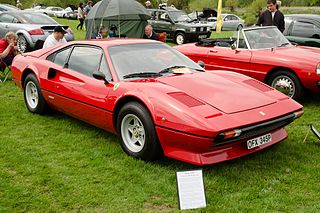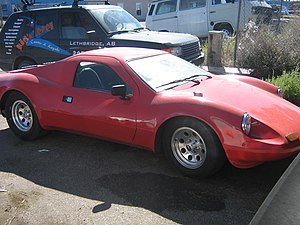
The Porsche 914 or VW-Porsche 914 is a mid-engined sports car designed, manufactured and marketed collaboratively by Volkswagen and Porsche from 1969 until 1976. It was only available as a targa-topped two-seat roadster powered by either a flat-4 or flat-6 engine.

The Chevrolet Corvair is a compact car manufactured by Chevrolet for model years 1960–1969 in two generations. A response to the Volkswagen Beetle, it remains the only American-designed, mass-produced passenger car with a rear-mounted, air-cooled engine. The Corvair was manufactured and marketed in 4-door sedan, 2-door coupe, convertible, 4-door station wagon, passenger van, commercial van, and pickup truck body styles in its first generation (1960–1964) and as a 2-door coupe, convertible or 4-door hardtop in its second (1965–1969) – with a total production of approximately 1.8 million from 1960 until 1969.

In automotive design, an RR, or rear-engine, rear-wheel-drive layout places both the engine and drive wheels at the rear of the vehicle. In contrast to the RMR layout, the center of mass of the engine is between the rear axle and the rear bumper. Although very common in transit buses and coaches due to the elimination of the drive shaft with low-floor buses, this layout has become increasingly rare in passenger cars.

A transaxle is a single mechanical device which combines the functions of an automobile's transmission, axle, and differential into one integrated assembly. It can be produced in both manual and automatic versions.

The Ferrari 308 GTB berlinetta and targa topped 308 GTS are V8 mid-engined, two-seater sports cars manufactured by the Italian company Ferrari from 1975 until 1985. The 308 replaced the Dino 246 GT and GTS in 1975 and was updated as the 328 GTB/GTS in 1985. The similar 208 GTB and GTS were equipped with a smaller, initially naturally aspirated and later turbocharged, two-litre engine, and were sold mainly in Italy.

The Ferrari 275 is a series of front-engined V12-powered grand touring automobiles with two-seater coupé and spider bodies produced by Ferrari between 1964 and 1968. The first 275 series cars were powered by a 3.3 L (3286 cc) overhead camshaft Colombo 60° V12 engine producing 260–320 hp (190–240 kW). An updated 275 GTB/4 was introduced in 1966, with a revised four overhead camshaft engine producing 300 hp (220 kW). The 275 series were the first road-going Ferraris equipped with a transaxle and independent rear suspension.

The Ferrari 550 Maranello is a front-engine V12 2-seat grand tourer built by Ferrari from 1996 to 2001. The 550 Maranello marked Ferrari's return to a front-engine, rear-wheel drive layout for its 2-seater 12-cylinder model, 23 years after the 365 GTB/4 Daytona had been replaced by the mid-engined Berlinetta Boxer.

The Chevrolet Turbo-Air 6 is a flat-six air-cooled automobile engine developed by General Motors (GM) in the late 1950s for use in the rear-engined Chevrolet Corvair of the 1960s. It was used in the entire Corvair line, as well as a wide variety of other applications.

The Ultima GTR is a super car manufactured by Ultima Sports Ltd of Hinckley, Leicestershire, England, and described by commentators as a supercar. The car was available both in kit form and as a "turnkey" vehicle until early 2015, when it was replaced by the Ultima Evolution. The design is mid engined, rear wheel drive layout, with a tubular steel space frame chassis and GRP bodywork. A convertible version called the Ultima Can-Am was also produced. Kit builders were free to source and fit a variety of engines and transmissions but the Chevrolet small block V8 supplied by American Speed mated to either a Porsche or Getrag transaxle was the factory recommended standard, and this configuration was fitted to all turnkey cars.

The De Tomaso Pantera is a mid-engine sports car produced by Italian automobile manufacturer De Tomaso from 1971 to 1992. Italian for "Panther", the Pantera was the automaker's most popular model, with over 7,000 manufactured over its twenty-year production run. More than three quarters of the production was sold by American Lincoln-Mercury dealers from 1972 to 1975; after this agreement ended De Tomaso kept manufacturing the car in ever smaller numbers into the early 1990s.
Hewland is a British engineering company, founded in 1957 by Mike Hewland, which specialises in racing-car gearboxes. Hewland currently employ 130 people at their Maidenhead facility and have diversified into a variety of markets being particularly successful in electric vehicle transmission supply.

The Avenger GT was a kit car produced by Fiberfab. It was designed in California and manufactured in the United States and Canada for 12 years, from late 1966 until 1978.

The Valkyrie is a GT sports car introduced in 1966 by the Fiberfab company. The Valkyrie's styling was inspired by the lines of the Ford GT40.
Manta Cars was owned and operated by American brothers Brad and Tim LoVette, and was located in Costa Mesa, California, from 1974 to 1986. Manta produced the Manta Mirage, and later produced other component kit cars, including the rear-engined Volkswagen Beetle-based Manta Montage, and the mid-engined Montage-T, which had a custom space frame chassis and used GM X-body V6 drivetrains. The Montage-T recreated the elusive McLaren M6GT.

Devin Enterprises was an American automotive manufacturer that operated from 1955 to 1964. Devin was mainly known for producing high quality fiberglass car bodies that were sold as kits, but they also produced automotive accessories as well as complete automobiles. The company was founded by Bill Devin.

Chevrolet Corvair Powerglide is a two-speed automatic transmission designed specially for the then all-new 1960 Chevrolet Corvair compact car that emerged in the fall of 1959 as Chevrolet's competitor in the then booming small car market. The Corvair was powered by a rear-mounted Chevrolet Turbo-Air 6 engine that necessitated a specially designed transaxle. Corvair Powerglide took the principles of the standard Chevrolet Powerglide and modified them to suit the rear-mounted powertrain location of the new Corvair. The Corvair used the Powerglide for all 10 years it was produced; from 1961 to 1969, Pontiac used a modified version of Corvair Powerglide it called 'TempesTorque' for its front-engine, rear-transaxle Tempest, LeMans and Tempest LeMans cars.
Fiberfab was an American automotive manufacturer established in 1964. Starting with accessories and body parts, they progressed to making kit cars and fully assembled automobiles. They became one of the longest lasting kit car manufacturers.

The ChevroletCorvair Monza GT (XP-777) was a mid-engined experimental prototype automobile built in 1962 and based on the early model Chevrolet Corvair series. As it was essentially a concept car, the Monza GT did not enter production.

The Porsche 981 is the internal designation given to the third-generation of the Boxster and second generation of the Cayman models built by German automobile manufacturer Porsche. It was announced on 13 March 2012 at the Geneva Auto Show with sales starting early summer 2012.
Colotti Trasmissioni is an Italian mechanical engineering firm located in Modena, Italy. It specializes in gears, limited-slip differentials and transmission systems for racing cars.

















